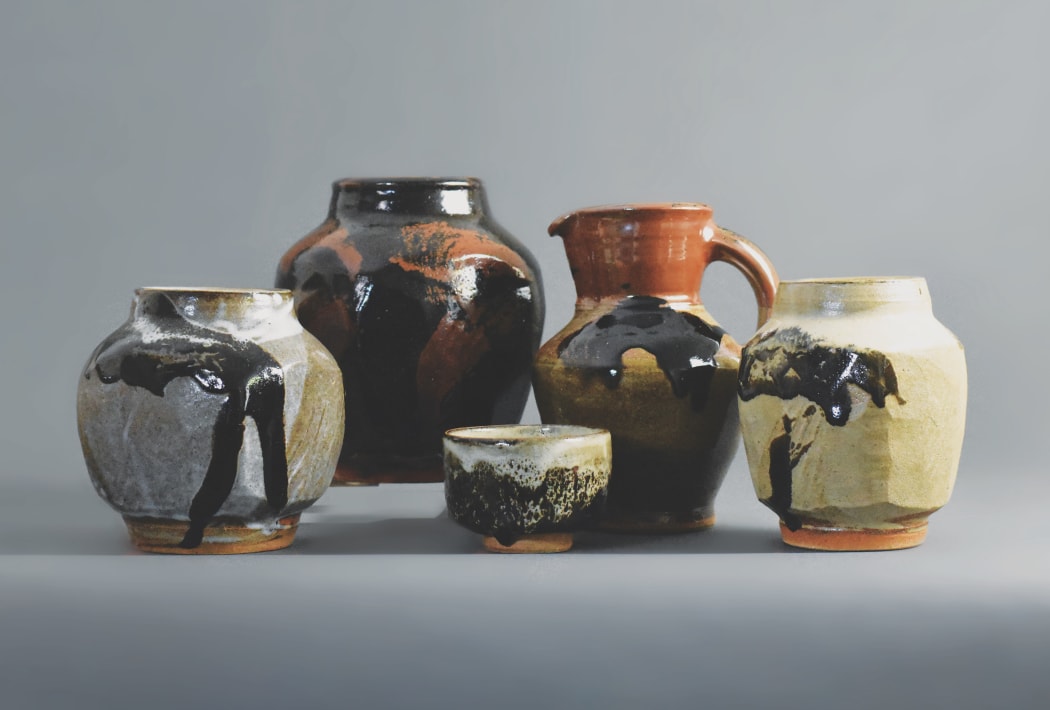
While we are excited to see new artists emerging on the stage of Japanese ceramic scene, we pause, and examine those who pioneered in the field; who looked into their own humble roots to be inspired.
In the 1950's Yanagi, Hamada and Kawai Kanjiro launched the Mingei movement where they were inspired by anonymous craftsmen. Yanagi validated Mashiko as a typical example of folk craft that embodies ‘innate Japaneseness’. From his experiences researching Western philosophical tenets and blending it with Japanese aesthetic philosophies, Yanagi constructed a “criterion of beauty” in Mingei, which included “the beauty of selflessness and anonymity.” This creed was inspired from his praise of a single object created by an illiterate, poor artisan called Minagawa Masu, who had been working for more than 60 years decorating sansui dobin (Tea pots with lids) with repetitive traditional patterns. His pots were unsigned, inexpensive, and ordinary kitchen items that lacked individuality. Inspired by Minagawa’s traditionality rooted in Buddhist precepts of collective creativity, Yanagi’s Mingei was thus conceived as a set of antithetical concepts, such as anonymity or tradition, vs individual creativity. From this emerged Murata Gen, a Mingei artist who subverted Yanagi’s movement towards defining a nationalized “Japanese” criterion of beauty. While creating pottery as a Mingei artist, he also began signing his works, thus removing the notion of anonymity. This clashed with Yanagi’s ideological sensibilities. Yanagi, who subscribed to anonymous craft as the ultimate expression of Japanese national cultural identities and values, disagreed with Murata’s attempt to expand the definition of Japanese criterion of beauty and art.
Born in 1904, Murata studied painting at the Kansai Bijutsu Gakuin (Kansai Art Academy). The onset of the first world war re-defined his career from painter to potter. After encountering Mashiko works in Tokyo, he followed in Hamada Shoji’s footsteps, whose Mashiko pottery he greatly admired. He displayed his hard-earned honed skill and mastery over traditional glazes such as Nuka (rice-husk), kaki-yu (persimmon), and various tetsu-yu (iron glazes) that are displayed in a scrolling pattern over his functional clay wares. Clay became his canvas, and his sensitivity to the clay medium, which simultaneously drew upon his training as a painter, was showcased, and he established himself at last as a Mingei potter.
However, unlike the anonymous craftsmen of his contemporaries- Yanagi Soetsu; Hamada Shoji- Murata Gen worked by himself and he consistently signed his work with a ‘む mu’. Murata sought to establish himself as an artist, blurring the lines between craftsmanship and high art. In doing so, he desired to elevate collective traditions of craft to the status of high art, which Yanagi saw as a misreading of Mingei. Essentially, he claimed that if an artists signs their work, it isn’t really Mingei. Murata’s desire to incorporate authorship into the Mingei tradition, and desire to expand the definition of craft, led to him being blacklisted from the Mingei collective by Yanagi himself. As a result, the sensitive, masterful works by this great artist and craftsman have been severely undervalued in the past. Certainly, his works push the boundaries of Mingei and by extension, definitions of Japanese values and criterion of beauty.
Murata’s inclinations to signing his works can also be historically traced within Mingei itself, which was developed in the construction of toyoshi, or “Oriental History.” As the historian Stefan Tanaka’s analysis reveals: Japan’s construction of the Orient modelled its own historiography on Occidental historiography, after much intellectual exchange between Japanese and Western scholars in the 1880s. Occidental history (seiyoshi), constructed the counterpart, Oriental history (toyoshi), playing a dual role that respected antiquity, but also incorporated the Occident into its world. This increasingly politicized historiogrpahy of toyo, led to the geopolitical impulses of Japan in the 20th century, which Murata ultimately responded to by incorporating the notion of specified narratives in each piece. What he saw as individual artistic expression was a counter to the political agendas of imperialism and colonialism in Japan. Murata’s spirit for specificity and authorship over craft-based narratives- realized through his painterly aura in his pots- was an attempt to deconstruct Yanagi’s toyo held deep within his Mingei theory. Murata Gen’s rhetoric of self-orientation countered the notion of a generalized “cultural” identity, moving away from the notion that strict criteria governed individual identity. Ultimately, he intercepted the mechanisms of toyo, thus realizing Mingei in a way that was not concerned with social labels, but rather form, surfacescape, and image. His works negotiated identity and self-hood within a post-war, nationalistic environment through form using a distinct interpretation of Mingei theory in Mashiko.
In Fall 2021, we exhibited a show, Terraform, that showed the lesser-known works of Murata Gen. His robust works reflect the harsh living environment and his unwavered spirit. His outstanding works quickly established himself in Mashiko, he had exhibitions every year in the great Tokyo area. His reputation grew beyond. In his late years, he was given a highest award by the Tochigi prefecture— cultural merit award for his outstanding artistic contribution.
Like Hamada Shoji, Murata’s clay and glazes are indigenous to Mashiko, unlike Hamada Shoji, Murata developed his own original style with layered, and mixed glazes. Like Hamada, he made many functional pieces for household use, unlike Hamada, His vases and jars are much heavier than functional pieces, he used clay to for his own artistic expression, like Hamada, he was inspired by Mingei, unlike Hamada he signed every of his pieces as he considered himself as an artist.
His works are a strong voice created during a turbulent period after the war in Japan during the 20th century. His vases not only have bodies, but also carry soul, you can hear his work. mixed rice husk glaze with black slip, that created landscape qualities. His vase tended to have high shoulders, faceted and with patch marks, they imbued strength, honesty and confidence.

